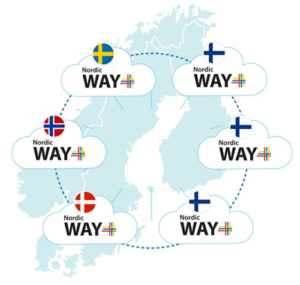The NordicWay 2 project, co-funded by the Connecting Europe Facility (CEF) programme, was set up to support the deployment of cooperative intelligent transport system (C-ITS) services in the Nordic countries (Denmark, Finland, Norway and Sweden). In addition to piloting, NordicWay 2 assessed the feasibility of C-ITS service provision by evaluating whether the services can be technically implemented, whether the general public accepts the services and is willing to use them, whether viable ecosystems can be built for service provision, and whether socioeconomic benefits can be expected and under which conditions.

Cellular networks support C-ITS services
The NordicWay approach was developed to support service interoperability in a C-ITS/ITS environment, where cloud services and entities are part of end-to-end solutions and connectivity is achieved using cellular and other communication links. Technical evaluation highlighted the need for designing robust and scalable solutions. For the purpose of the pilots, the measured latencies did not hinder services. The cross-organisational data sharing and the data sharing across the interchange system and between countries was confirmed, even though, there were some issues in cross-border situations. The cellular networks was proven to support C-ITS services, delivering excellent economy of scale and nationwide road network coverage.
Users tentatively positive about C-ITS services
The user acceptance evaluation showed that over half of Nordic drivers have never heard of C-ITS services and that very few have used them. The most important information contents on motorways or main roads were those indicating some kind of road blockage (accident, obstacle, closure) or large animals on the road. For urban environment, the top three contents were warnings on emergency vehicle approaching, accident ahead and road or lane closure. In all, 44% of the drivers stated that they would be willing to use C-ITS services always or on most of their trips, especially on longer trips and on unfamiliar routes.
Public sector has active role in C-ITS development
The ecosystem evaluation showed that ramp-up phase challenges included contracts and especially GDPR personal data implications for data access and agility; geographical and temporal service coverage and technical issues like assurance of data quality across the ecosystem. Their pains included also challenges in attracting users and thin revenue streams from private users, but also investment challenges and lack of a skilled workforce. The gains that the ecosystems expected were related to revenue, clientele growth, product portfolio and international partnerships. The actors acknowledged that the public sector has had a significant role in the early stages of C-ITS development, and that active participation will also be needed in the long run.The NordicWay 2 project was set up to support the deployment of C-ITS services in the Nordic countries.


Socio-economic benefits expected to exceed costs by 2030
The socioeconomic impact assessment indicated that as a specific response to the service, the amount of travel is likely affected by the route guidance type of services on unfamiliar routes. Public transport priorities may impact mobility by making the use of public transport more attractive via improved punctuality and reduced travel time. C-ITS services for car drivers in general may also influence mobility by making one’s own car a more attractive travel option due to increased awareness and a feeling of being better informed. The estimates of direct safety effects were largest for in-vehicle speed limits and warnings on emergency braking, slow/stationary vehicles and traffic jam ahead. Important efficiency effects were expected to result from a reduction of crash-related congestion due to fewer road crashes and from the decreased distance driven due to the above mobility effects. The environmental impacts were expected mainly due to changes in modal choice, vehicle kilometres driven and vehicle speeds.
The comparison of costs and benefits indicates that from the road operator perspective, in 2030 the benefits even in the low effectiveness scenario will exceed the sum of annual operating and maintenance costs that year and the investment costs up to that year in all countries. Yet, sensitivity analysis showed that the outcome of socioeconomic impact assessment depended highly on the made assumptions on the coverage, use and effectiveness of the services.
Conclusions
The main conclusion was that it is technically feasible to set up C-ITS services in the Nordic countries. Challenges for service provision include most potential users never having heard of C-ITS services and their willingness to pay for them being low. However, they were willing to use these services and share data with the service providers. In addition, feasible business models and ecosystems still require a solution with some public involvement, intervention, funding or investment in the longer term and, thus, definition of the public actors in the ecosystems. If these challenges are solved and a sufficient user base and good coverage of services are achieved for the C-ITS services, socioeconomic benefits can be expected. The monetary value of these benefits is expected to outweigh the sum of the annual operating and maintenance costs in 2030 and the investment costs up until then in all countries from the road operator perspective. It was recommended to focus the operation of C-ITS services on roads with high traffic volumes.
The report is available in fulltext:
NordicWay 2 (2020): Evaluation results
Text: Satu Innamaa, VTT

Contact:
Satu Innamaa
satu.innamaa@vtt.fi
VTT Technical Research Centre of Finland Ltd., Finland






Follow us: